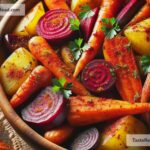How Fruit and Vegetable Size Influences Taste Intensity
When we bite into an apple or slice up a tomato, we rarely think about how its size might affect the flavor. Most of us focus on freshness, texture, or color, but size plays a surprisingly important role in the taste intensity of fruits and vegetables. From tiny berries to giant zucchinis, this factor can influence the sweetness, bitterness, and overall flavor experience. Let’s break it down in simple terms.
Big or Small: Why Size Matters in Taste
The size of fruits and vegetables isn’t just about convenience or presentation; it’s tied to their chemical and physical makeup. Plants, like any living things, have a balance of water, sugar, acids, and nutrients inside. The proportion of these components changes depending on the size of the produce, which can directly impact how we experience the flavor.
For example, smaller fruits and vegetables often have more concentrated flavors while larger ones may taste milder or more diluted. This happens because smaller produce usually contains less water and a higher concentration of sugar, acid, and other flavor molecules. On the flip side, larger produce can sometimes hold more water within their cells, making the taste less intense.
Small Fruits and Vegetables: Packed with Flavor
Ever wondered why small strawberries taste sweeter than gigantic ones or why tiny cherry tomatoes pack more punch than regular tomatoes? It’s because their size impacts how their natural sugars and acids are distributed. Small fruits and veggies are often denser in flavor because they don’t contain as much water to “dilute” their taste.
For instance, in strawberries, the sugar content is more concentrated in smaller ones. A bite from a small, ripe strawberry feels like a burst of sweetness, while a larger strawberry may taste less vibrant. The same goes for cherry tomatoes, which are well-loved for their intense flavor compared to larger tomato varieties.
Another example is baby carrots versus full-grown carrots. Baby carrots tend to be sweeter and crunchier because they’re harvested earlier and have a more concentrated flavor profile. Larger carrots can sometimes develop a woody texture and a less complex taste.
Larger Fruits and Vegetables: Mild but Easy to Eat
Large fruits and vegetables can have their own appeal. While they might not offer the intense flavors of smaller ones, they are often easier to eat and work well in dishes that require blending, cooking, or mixing. For example, large zucchinis and cucumbers have a milder taste, making them ideal for soups, smoothies, or salads where other flavors dominate.
There’s also a reason why farmers let some vegetables grow bigger—they tend to have more flesh, which often makes them easier to process. Think of large pumpkins used in pies or big watermelons with enough juice for everyone to share. However, these larger varieties can sometimes develop a bland or watered-down flavor compared to smaller, sweeter versions.
Why Do Bigger Fruits and Vegetables Taste Less Intense?
Not all big fruits and vegetables taste bland, but many do lose intensity compared to their smaller counterparts. Here are the main reasons:
- Water Content: Larger produce often has more water inside, which spreads out the sugars and acids, making the flavor less concentrated.
- Ripeness: Smaller fruits and vegetables are often harvested when they’re fully ripe, while larger ones might take longer to ripen. If picked too early, bigger produce may lack sweetness or zest.
- Growth Conditions: The way plants are grown—how much sunlight, water, and nutrients they receive—affects their flavor profile. Sometimes, growers prioritize size over taste, leading to bigger but less flavorful produce.
What About Cooking and Preparation?
Cooking can dramatically change the taste intensity of fruits and vegetables. Larger vegetables like zucchini or eggplant may not taste very sharp on their own, but roasting or grilling them can bring out their hidden flavors. Heat causes natural sugars to caramelize, enhancing the sweetness.
For smaller fruits and veggies like cherry tomatoes or berries, their natural flavor intensity makes them perfect for raw dishes or light cooking. You don’t need to add much seasoning or effort—they already taste great on their own!
Best Practices for Choosing Fruits and Vegetables
When shopping for fruits and vegetables, size can be an important clue for flavor. Here are some tips:
-
Choose Smaller for Snacks: If you’re looking for intense, sweet flavors, go for smaller produce like baby carrots, small tomatoes, or tiny berries. They’ve got the best concentration of taste.
-
Bigger for Cooking: Larger fruits and vegetables can work well in recipes where their mild flavor complements other ingredients or requires blending (like soups or casseroles).
-
Check Ripeness: No matter the size, ripeness is key! A smaller unripe fruit won’t taste better than a ripened larger one.
Conclusion
The size of fruits and vegetables plays a surprising role in how intense their flavors are. Smaller ones often deliver concentrated tastes that elevate your meals and snacks, while larger ones offer a milder profile, ideal for blending and cooking. Whether you’re shopping for tiny berries or oversized squash, understanding this connection can help you pick the right produce for your needs—and make every meal a little tastier! Taste isn’t just about color or freshness; sometimes, bigger isn’t always better when it comes to flavor!


